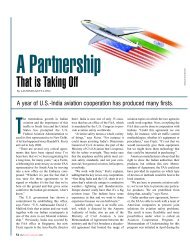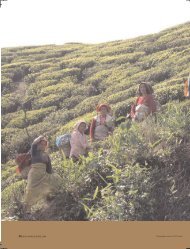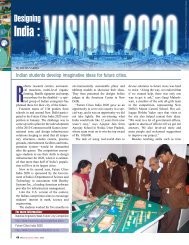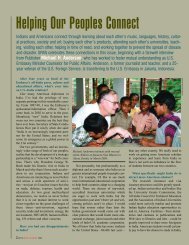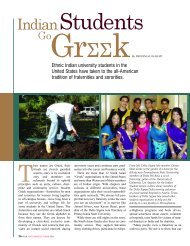You also want an ePaper? Increase the reach of your titles
YUMPU automatically turns print PDFs into web optimized ePapers that Google loves.
<strong>Menu</strong><br />
<str<strong>on</strong>g>Masala</str<strong>on</strong>g><strong>on</strong><br />
<strong>the</strong><br />
How U.S. Food Chains Cater to Indian Tastes<br />
Text by E. WAYNE Photographs by SEBASTIAN JOHN<br />
Pizza Hut employee<br />
Satveer Singh prepares to<br />
serve Malai Seekh Kebab<br />
Pizza (left) and Peshawari<br />
Chana Paneer Pizza, <strong>the</strong><br />
Indian additi<strong>on</strong>s to <strong>the</strong> U.S.<br />
restaurant chain’s menu.<br />
Pizza, as we know it, was invented in 1889 in Naples, Italy,<br />
by D<strong>on</strong> Raffaele Esposito as a dish for his queen. The<br />
Peshawari Chana Paneer Pizza, a more recent innovati<strong>on</strong>,<br />
was developed by Pizza Hut India’s marketing and<br />
research team, headed by Sanjiv Mediratta. The intended<br />
c<strong>on</strong>sumer? Any<strong>on</strong>e craving “The Great Indian Treat.”<br />
According to Smiths<strong>on</strong>ian magazine, Esposito used buffalo<br />
mozzarella <strong>on</strong> his groundbreaking pizza, a new ingredient to be<br />
melted atop flat bread. Mediratta also added a significant innovati<strong>on</strong><br />
to <strong>the</strong> pizza art form—chickpeas.<br />
As with most new ideas, people scoffed at first. “When I was<br />
doing this pizza, every<strong>on</strong>e put me down and said, ‘We can’t put<br />
chickpeas <strong>on</strong> it; <strong>the</strong>re is no value.’ I said, if you look at an Indian<br />
c<strong>on</strong>sumer, he eats bhatura, which is a bread, and he eats it with<br />
34 <strong>SPAN</strong> SEPTEMBER/OCTOBER 2006<br />
chana. My crust is also a bread. So I just need to put some chana<br />
and <strong>on</strong>i<strong>on</strong> <strong>on</strong> top of it,” says Mediratta, a former Taj Hotel chef<br />
who prefers to eat at roadside dhabas instead of five-star hotels.<br />
He chucked <strong>the</strong> basil topping of <strong>the</strong> original “Margherita”<br />
pizza in favor of <strong>on</strong>i<strong>on</strong>s, paneer, soft chickpeas, fresh coriander<br />
and a sprinkling of masala. The result: Peshawari Chana Paneer<br />
Pizza is now <strong>on</strong>e of <strong>the</strong> best selling items in Pizza Hut’s vegetarian<br />
range. “It’s <strong>the</strong> c<strong>on</strong>sumer who decides what he wants, not<br />
us,” says Mediratta.<br />
And that has been <strong>on</strong>e of <strong>the</strong> greatest less<strong>on</strong>s for U.S.-based<br />
restaurant chains as <strong>the</strong>y entered <strong>the</strong> Indian market: Indian c<strong>on</strong>sumers<br />
crave Indian flavors. Give <strong>the</strong>m a chicken burger, but<br />
make it with mint sauce. Or a submarine sandwich with spicy<br />
potato patties. Keep <strong>the</strong> internati<strong>on</strong>al standard of service, clean-
liness and food quality. Keep <strong>the</strong> food’s form and functi<strong>on</strong> <strong>the</strong><br />
same. But a little masala never hurt any<strong>on</strong>e.<br />
From unsure and sometimes rough beginnings, American<br />
food chains are growing fast in India now. Papa John’s just<br />
entered and KFC is resurgent. McD<strong>on</strong>ald’s now has 91 restaurants<br />
in India and feeds 350,000 people a day. Pizza Hut had 126<br />
restaurants in July and is expanding fast into small towns, as is<br />
Subway, with 79 restaurants.<br />
In fact, Indian menu opti<strong>on</strong>s have become standard for<br />
American chains here. Says Robby Gulri, a Subway representative<br />
in India, “When we first introduced Subway in India, we<br />
<strong>on</strong>ly had our internati<strong>on</strong>al selecti<strong>on</strong> of subs. In line with customer<br />
feedback and popular demand we gradually introduced a variety<br />
of Indian subs. These were developed in collaborati<strong>on</strong> with our<br />
From top: A staffer explains <strong>the</strong> menu to a customer at McD<strong>on</strong>ald’s;<br />
<strong>the</strong> KFC outlet at Rajouri Garden, New Delhi; customers at Pizza Hut.<br />
local vendors and <strong>the</strong> R&D department at Subway headquarters,<br />
in Milford, C<strong>on</strong>necticut.”<br />
Newcomer Papa John’s didn’t have to suffer <strong>the</strong> learning<br />
curve of early entrants like Pizza Hut and Domino’s Pizza<br />
(which, like Subway, both started out with <strong>on</strong>ly standard offerings).<br />
Papa John’s launched its restaurants with a host of Indianstyle<br />
pizzas already <strong>on</strong> <strong>the</strong> menu.<br />
The success of <strong>the</strong> shift speaks for itself. In India, <strong>the</strong> top sell- BUSINESS<br />
ing McD<strong>on</strong>ald’s product is <strong>the</strong> McAloo Tikki, a Rs. 20 potato<br />
burger with spices, tomato slices and a tangy sauce. But making<br />
a bestseller isn’t just about whipping up w<strong>on</strong>ders in <strong>the</strong> kitchen: FOOD<br />
<strong>SPAN</strong> SEPTEMBER/OCTOBER 2006 35
It’s a l<strong>on</strong>g, complicated process involving marketing, supply<br />
chains, kitchen staff and countless tests of taste and pricing.<br />
That new, delicious looking dish advertised in <strong>the</strong> newspaper<br />
often takes more than a year to develop from c<strong>on</strong>cept to reality.<br />
Fast-food and chain restaurants like McD<strong>on</strong>ald’s and Pizza Hut<br />
are all about volumes; <strong>the</strong>refore, every new offering actually<br />
starts in marketing. That department collects customer feedback,<br />
runs focus groups, watches sales trends and does its best to find<br />
out what customers are craving.<br />
Once a trend is established, marketing c<strong>on</strong>sults chefs and<br />
o<strong>the</strong>r food developers to come up with offerings to reflect it.<br />
Samples are <strong>the</strong>n taken to c<strong>on</strong>sumers in focus groups, who are<br />
not allowed to eat <strong>the</strong> offerings—yet. They’re simply told about<br />
<strong>the</strong> product, and asked if <strong>the</strong>y would want to buy it.<br />
Fresh iceberg lettuce from Trikaya<br />
Agriculture, Talega<strong>on</strong>, Maharashtra; Ooty Farms,<br />
Tamil Nadu; and Meena Agritech, New Delhi<br />
Batter and breading<br />
from Cremica EBI,<br />
Ludhiana, Punjab<br />
After narrowing <strong>the</strong> choices from <strong>the</strong> feedback, an in-house<br />
team rates <strong>the</strong> selecti<strong>on</strong>s <strong>on</strong> taste, presentati<strong>on</strong> and feasibility.<br />
After this, products are again sent to <strong>the</strong> focus groups, but this<br />
time, <strong>the</strong>y get a taste. If <strong>the</strong> c<strong>on</strong>sumers like <strong>the</strong> taste, <strong>the</strong>n it’s off<br />
to <strong>the</strong> biggest test of all: suppliers. Can <strong>the</strong> meat suppliers mass<br />
produce a kebab that tastes just right and doesn’t cost a fortune?<br />
Will <strong>the</strong> breadsticks crumble before <strong>the</strong>y are delivered?<br />
If <strong>the</strong> suppliers can produce <strong>the</strong> ingredients, <strong>the</strong>n it’s <strong>on</strong> to a<br />
restaurant test where a branch is chosen to sell and serve <strong>the</strong><br />
product. Can <strong>the</strong> kitchen workers prepare it properly? Is <strong>the</strong> price<br />
too high? Can <strong>the</strong> waiters explain what goes into <strong>the</strong> item? And,<br />
of course, <strong>the</strong> bottom line: does it sell? Only after all <strong>the</strong>se questi<strong>on</strong>s<br />
are answered does that hot bite end up <strong>on</strong> your lunch tray.<br />
Some bright ideas from India have even g<strong>on</strong>e internati<strong>on</strong>al. In<br />
Pizza Hut’s case, <strong>the</strong> U.S.-based parent introduced a stuffed<br />
crust pizza with strips of mozzarella cheese baked into <strong>the</strong><br />
edges. However, Indians aren’t fans of cheese as much as<br />
Americans are, and <strong>the</strong> pizza didn’t sell well here. Instead,<br />
Indian c<strong>on</strong>sumers wanted more meat. After playing around with<br />
36 <strong>SPAN</strong> SEPTEMBER/OCTOBER 2006<br />
Buns from<br />
Cremica, Ludhiana,<br />
Punjab<br />
Vegetable patty<br />
from Kitran Foods,<br />
Taloja, Maharashtra<br />
crust stuffing technology, Mediratta and his team found a way to<br />
stuff sausages into <strong>the</strong> crust instead of cheese. It was a hit. After<br />
that, it was just a matter of time before o<strong>the</strong>r countries picked up<br />
<strong>the</strong> same feature, and sausage crust pizza went worldwide.<br />
Innovati<strong>on</strong>s aren’t limited to <strong>the</strong> food ei<strong>the</strong>r. When<br />
McD<strong>on</strong>ald’s started its delivery service, a feature of many of its<br />
branches in Asian countries, it came up<strong>on</strong> a problem for its<br />
Chandni Chowk branch in New Delhi. “As a model, we use specially<br />
modified and branded scooters for delivery,” says Pawanjit<br />
Singh, who heads <strong>the</strong> delivery divisi<strong>on</strong> for McD<strong>on</strong>ald’s India.<br />
“But looking at <strong>the</strong> traffic c<strong>on</strong>gesti<strong>on</strong> in Chandni Chowk, we felt<br />
that scooters would not allow us to deliver <strong>the</strong> orders in time. We<br />
finally decided up<strong>on</strong> bicycles.”<br />
Men <strong>on</strong> bikes take up less space and can zip through <strong>the</strong><br />
crowded streets much faster. This is important, c<strong>on</strong>sidering <strong>the</strong><br />
walled city is said to hold an estimated <strong>on</strong>e milli<strong>on</strong> people. And<br />
if it’s terribly crowded—say, at<br />
5:30 p.m. <strong>on</strong> a weekday—<strong>the</strong><br />
delivery men have even been<br />
known to walk to nearby destina-<br />
Sesame seeds<br />
from Ghaziabad,<br />
Uttar Pradesh<br />
Special eggless<br />
sauce from Mrs. Bector<br />
Foods, Phillaur, Punjab<br />
Graphic courtesy McD<strong>on</strong>ald’s<br />
ti<strong>on</strong>s. It’s <strong>the</strong> <strong>on</strong>ly branch of<br />
McD<strong>on</strong>ald’s worldwide to have<br />
this unique form of delivery.<br />
But how much Indian flavor is<br />
too much? When do you stop catering<br />
to local tastes and start diluting<br />
your core product? It’s a delicate<br />
balance that marketers and chefs<br />
have to handle every time <strong>the</strong>y<br />
work <strong>on</strong> a new menu offering.<br />
Says Mediratta, “Our c<strong>on</strong>sumer<br />
research shows that people<br />
say <strong>the</strong>y want an internati<strong>on</strong>al<br />
c<strong>on</strong>cept but with an Indian heart.<br />
They d<strong>on</strong>’t want butter chicken;<br />
for that <strong>the</strong>y can go to o<strong>the</strong>r<br />
places. When <strong>the</strong>y come here<br />
<strong>the</strong>y still want an internati<strong>on</strong>al<br />
pizza, so we have to be very careful when we do <strong>the</strong> balancing<br />
<strong>on</strong> our menu.” For that reas<strong>on</strong>, he’s decided not to tamper with<br />
his core ingredients: crust, cheese and sauce.<br />
In additi<strong>on</strong> to finding <strong>the</strong> right food elements, <strong>the</strong> o<strong>the</strong>r assets<br />
of chain restaurants play a huge role in keeping <strong>the</strong> brand internati<strong>on</strong>al.<br />
The staff speak English and are trained in customer<br />
service; <strong>the</strong> ambience is clean and well-lit with a modern feel;<br />
and <strong>the</strong> ingredients are all prepared in hygienic c<strong>on</strong>diti<strong>on</strong>s identical<br />
to <strong>the</strong> requirements in <strong>the</strong> United States. Surprise visits are<br />
made at least <strong>on</strong>ce a m<strong>on</strong>th to each franchise by an undercover<br />
customer, and if standards are not met, <strong>the</strong> restaurant will be<br />
penalized or even shut down.<br />
One integral feature of all <strong>the</strong> Indian branches of American<br />
brands is vegetarian offerings. Workers in different parts of <strong>the</strong><br />
kitchen keep <strong>the</strong> meat-based products strictly separated. This<br />
scrupulous behavior was learned <strong>the</strong> hard way. KFC was<br />
plagued by allegati<strong>on</strong>s of animal rights abuses in its chicken<br />
sourcing, and McD<strong>on</strong>ald’s received a lot of flak over an allegati<strong>on</strong><br />
of small amounts of beef in <strong>the</strong> oil used to cook vegetarian
Tasty Bite India Coming to American Tables<br />
Madras lentils made in Pune, Maharashtra,<br />
are finding <strong>the</strong>ir way <strong>on</strong>to<br />
American dinner tables thanks to<br />
food packaging technology invented for <strong>the</strong><br />
Apollo space program, and a growing<br />
company, Tasty Bite. Its motto is “Taking<br />
Indian food to <strong>the</strong> mainstream,” and company<br />
President Ashok Vasudevan has d<strong>on</strong>e<br />
just that.<br />
Tasty Bite now sells nati<strong>on</strong>ally in U.S.<br />
grocery stores like Safeway, Costco and<br />
Trader Joe’s. Vasudevan also estimates that<br />
98 percent of his c<strong>on</strong>sumers are n<strong>on</strong>-Indian.<br />
Started in India during <strong>the</strong> 1990s, Tasty<br />
Bite made ready-to-eat meals in specially<br />
sealed packs like those used for army<br />
rati<strong>on</strong>s. It was a new technology that India<br />
products, which <strong>the</strong> company denied.<br />
Arvind Mediratta, marketing director of Yum Foods India,<br />
spoke of <strong>the</strong> trouble first experienced by <strong>the</strong> company’s brands.<br />
“When KFC came in, <strong>the</strong> political envir<strong>on</strong>ment was not very<br />
c<strong>on</strong>ducive to <strong>the</strong> entry of multinati<strong>on</strong>als. There was a lot of hue<br />
and cry raised by politicians saying that KFC is junk food. They<br />
said, ‘We d<strong>on</strong>’t need multinati<strong>on</strong>als to serve us chicken. We<br />
have our own tandoori chicken.’ While <strong>the</strong>re was so much heat<br />
<strong>on</strong> KFC, we moved <strong>the</strong> focus to Pizza Hut.”<br />
Much has happened since 1995 when KFC first launched.<br />
Foreign direct investment rules have been liberalized, <strong>the</strong> average<br />
salary has risen and <strong>the</strong> Indian government is now wooing multinati<strong>on</strong>al<br />
companies, not shunning <strong>the</strong>m. All <strong>the</strong>se factors were motivati<strong>on</strong>s<br />
to relaunch KFC in metros like New Delhi and Calcutta.<br />
And KFC has re-launched with a new menu that’s pretty radical<br />
for a restaurant known for its chicken. Its vegetarian range<br />
includes a chana burger and Indian thalis. Says Arvind<br />
Mediratta, “When we talk about <strong>the</strong> KFC brand, we’re not talking<br />
about chicken; our positi<strong>on</strong>ing is around taste.”<br />
Though it’s too early to gauge <strong>the</strong> success of <strong>the</strong> vegetarian<br />
menu, price will obviously play a part in KFC’s sales. Ten years<br />
ago, it sold two pieces of chicken for Rs. 60 and saw customers<br />
balk at <strong>the</strong> amount. Today KFC is selling two pieces for Rs. 5<br />
more, and catering to a whole new income bracket.<br />
American restaurant chains have all been getting aggressive<br />
in pricing in recent years. Many began with prices that reflected<br />
those in <strong>the</strong> West and <strong>the</strong>ir products were regarded as a luxury.<br />
Now McD<strong>on</strong>ald’s has a Rs. 20 menu, Subway has Rs. 50 sandwiches<br />
and Pizza Hut has a meal package of ice cream, pizza<br />
and soup for Rs. 75. All reported a significant boost in sales<br />
since introducing lower pricing.<br />
And as <strong>the</strong>y make <strong>the</strong>ir food affordable to a whole new secti<strong>on</strong><br />
of customers, <strong>the</strong>y are also helping Indian farmers and suppliers<br />
become more efficient and knowledgeable. Processed<br />
food is still quite new and underdeveloped here, and it’s not<br />
uncomm<strong>on</strong> for Indian vendors for American chains to be sent <strong>on</strong><br />
exchange programs to <strong>the</strong> United States or Europe to learn new<br />
wasn’t ready for. However, America was.<br />
Seeing <strong>the</strong> trends of food experimentati<strong>on</strong><br />
and ready-made meals in <strong>the</strong> U.S.<br />
market, Tasty Bite launched in 1995, billing<br />
its products as natural, ethnic food. The<br />
Indian meals sold in health food stores<br />
Courtesy Tasty Bite<br />
because <strong>the</strong>y had no preservatives and no<br />
added flavors.<br />
At first, sales were sluggish. One problem<br />
was <strong>the</strong> product names. “The words <strong>on</strong> <strong>the</strong><br />
pack were a mouthful,” says Vasudevan,<br />
“so Navratan Korma became Jaipur<br />
Vegetables.” They also had to wait a little<br />
while for American tastes to evolve. “We<br />
were surprised at <strong>the</strong> reacti<strong>on</strong> to our<br />
Kashmir Spinach. The spinach in <strong>the</strong> U.S. is<br />
very fibrous....Our spinach was often looked<br />
at as baby food because it was very gooey.”<br />
Now Kashmir Spinach is a top seller.<br />
Tasty Bite is expanding, and its 120str<strong>on</strong>g<br />
staff is now making Thai, Italian,<br />
Chinese and Mediterranean meals at <strong>the</strong><br />
producti<strong>on</strong> center in Pune. —E.W.<br />
processes and recipes.<br />
Neerja Bharat of McD<strong>on</strong>ald’s recalls <strong>the</strong> company’s Indian<br />
launch in <strong>the</strong> early 1990s and <strong>the</strong> extensive search for good<br />
suppliers. “India had no technical know-how and expertise <strong>on</strong><br />
how to grow lettuce,” she says. “We needed lettuce that would<br />
crunch when you bite it.” It took McD<strong>on</strong>ald’s six years to get <strong>the</strong><br />
lettuce right, al<strong>on</strong>g with o<strong>the</strong>r key food comp<strong>on</strong>ents. The company<br />
finally settled <strong>on</strong> farming it in Ooty, Tamil Nadu, and<br />
taught <strong>the</strong> vendors advanced drip irrigati<strong>on</strong> methods. The vendors<br />
now plan <strong>on</strong> exporting lettuce to McD<strong>on</strong>ald’s in o<strong>the</strong>r<br />
countries as well.<br />
Pizza Hut had similar problems with pepper<strong>on</strong>i when <strong>the</strong><br />
Indian government banned its import. Sanjiv Mediratta knew he<br />
had to arrange something, as customers were clamoring for <strong>the</strong><br />
Italian sausage. After interviewing many vendors, he settled <strong>on</strong><br />
a small pork slaughterhouse called Farm Suzanne, in Chennai.<br />
The owners were already catering to o<strong>the</strong>r packaged food makers,<br />
but were still not up to internati<strong>on</strong>al standards. Plus, <strong>the</strong>y<br />
had no idea how to make pepper<strong>on</strong>i.<br />
So Yum Foods brought <strong>on</strong>e of its vendors from Australia to<br />
teach pepper<strong>on</strong>i processes and seas<strong>on</strong>ing. Every window in <strong>the</strong><br />
plant had to be shut, <strong>the</strong> building had to be kept at 10 degrees<br />
Celsius at all times, and lots of new equipment was needed.<br />
These were all expensive for a small vendor to handle, but Farm<br />
Suzanne did it. It now produces au<strong>the</strong>ntic Indian-made pepper<strong>on</strong>i<br />
in perfectly uniform slices that taste just like <strong>the</strong> internati<strong>on</strong>al<br />
stuff. Pepper<strong>on</strong>i lovers can now brea<strong>the</strong> easy; Pizza Hut will<br />
be reintroducing <strong>the</strong> signature dish so<strong>on</strong>.<br />
And what of customers from America or Europe who are<br />
searching for a familiar taste from home? Vijay Kadian, manager<br />
of a Pizza Hut in Gurga<strong>on</strong>, outside New Delhi, says that<br />
Western customers in <strong>the</strong> business hub regularly order <strong>the</strong> local<br />
pizzas. “They are visiting a brand like Pizza Hut but <strong>the</strong>y are in<br />
India, and want a taste of Indian food as well. They order <strong>the</strong><br />
Indian pizzas.” But, he admits, “without <strong>the</strong> green chilies.” �<br />
E. Wayne is a freelance writer based in New Delhi.<br />
<strong>SPAN</strong> SEPTEMBER/OCTOBER 2006 37





